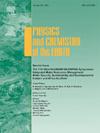灌溉区和非灌溉区地下水的水化学特征及其控制机制--中国关中平原的比较研究
IF 3
3区 地球科学
Q2 GEOSCIENCES, MULTIDISCIPLINARY
引用次数: 0
摘要
深入了解灌区地下水化学及其演变对优化灌溉策略至关重要。本研究探讨了中国关中平原灌溉区和非灌溉区地下水化学的起源和影响变量,旨在阐明灌溉措施如何影响水化学变化。研究采用了水化学数据、同位素数据、多元统计技术和水化学方法。研究结果表明,非灌溉区的地下水溶解固体总量(TDS)较低,90% 的地下水样本呈现 HCO3-Ca-Mg 类型。相比之下,灌溉区的地下水总溶解固体(TDS)含量较高,水化学类型多样,包括 HCO3-Ca-Mg、HCO3-Na 和 SO4-Cl-Ca-Mg 类型。这些类型共占灌区水样的 88%。同位素和水化学分析表明,灌溉区的地下水经历了更频繁的蒸发和阳离子交换。此外,污水和粪便等人为活动对灌区地下水化学成分的影响更为明显。从西部灌区到东部灌区,地下水的灌溉适宜性有所下降。这项研究为精心管理和保护该地区的地下水资源奠定了坚实的科学基础。本文章由计算机程序翻译,如有差异,请以英文原文为准。
Hydrochemical characteristics of groundwater and their controlling mechanisms in irrigation and non-irrigation areas - A comparative study in the Guanzhong Plain of China
Gaining insight into groundwater chemistry and its evolution in irrigation areas is essential for optimizing irrigation strategies. This study explores the origins and influencing variables of groundwater chemistry across both irrigated and non-irrigated areas of the Guanzhong Plain, China, aiming to elucidate how irrigation practices impact hydrochemical changes. Hydrochemical data, isotopic data, multivariate statistical techniques and hydrochemical methods were used in this study. The findings underscored that groundwater in the non-irrigation areas had low total dissolved solids (TDS), with 90% of the groundwater samples exhibiting the HCO3–Ca·Mg type. In comparison, groundwater from the irrigation areas showed elevated TDS levels and diverse hydrochemical types, including HCO3–Ca·Mg, HCO3–Na, and SO4·Cl–Ca·Mg types. These categories collectively represented 88% of the water samples from the irrigation areas. Isotopic and hydrochemical analyses revealed that groundwater in the irrigation areas experienced more intense evaporation and cation exchange. Furthermore, anthropogenic activities like sewage and manure had a more pronounced effect on groundwater chemistry in the irrigation areas. Groundwater suitability for irrigation deteriorated from the western irrigation area to the eastern irrigation area. This research offers a robust scientific foundation for the careful management and conservation of groundwater resources in the region.
求助全文
通过发布文献求助,成功后即可免费获取论文全文。
去求助
来源期刊

Physics and Chemistry of the Earth
地学-地球科学综合
CiteScore
5.40
自引率
2.70%
发文量
176
审稿时长
31.6 weeks
期刊介绍:
Physics and Chemistry of the Earth is an international interdisciplinary journal for the rapid publication of collections of refereed communications in separate thematic issues, either stemming from scientific meetings, or, especially compiled for the occasion. There is no restriction on the length of articles published in the journal. Physics and Chemistry of the Earth incorporates the separate Parts A, B and C which existed until the end of 2001.
Please note: the Editors are unable to consider submissions that are not invited or linked to a thematic issue. Please do not submit unsolicited papers.
The journal covers the following subject areas:
-Solid Earth and Geodesy:
(geology, geochemistry, tectonophysics, seismology, volcanology, palaeomagnetism and rock magnetism, electromagnetism and potential fields, marine and environmental geosciences as well as geodesy).
-Hydrology, Oceans and Atmosphere:
(hydrology and water resources research, engineering and management, oceanography and oceanic chemistry, shelf, sea, lake and river sciences, meteorology and atmospheric sciences incl. chemistry as well as climatology and glaciology).
-Solar-Terrestrial and Planetary Science:
(solar, heliospheric and solar-planetary sciences, geology, geophysics and atmospheric sciences of planets, satellites and small bodies as well as cosmochemistry and exobiology).
 求助内容:
求助内容: 应助结果提醒方式:
应助结果提醒方式:


